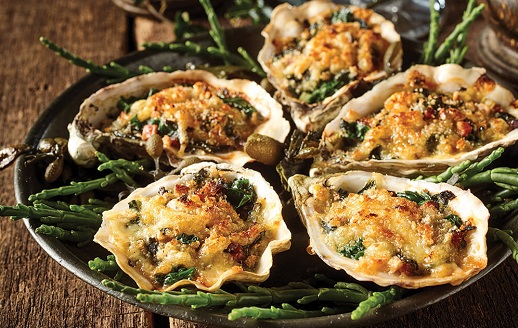Oysters Rockefeller
Oysters Rockefeller is a luxurious and iconic dish that has graced the menus of fine dining establishments for over a century. This rich, savory appetizer features fresh oysters on the half-shell, topped with a luscious blend of green herbs, butter, and breadcrumbs, then baked or broiled to perfection.
The dish was created in 1899 by Jules Alciatore at Antoine’s Restaurant in New Orleans, Louisiana. Legend has it that Jules developed the recipe due to a shortage of snails, which were used in the popular Escargots Bourguignonne. He named the dish after John D. Rockefeller, the richest American at the time, because of its richness.
The exact original recipe remains a closely guarded secret at Antoine’s, but numerous variations have emerged over the years.
Most modern versions include a mixture of green herbs (often spinach), butter, breadcrumbs, and seasonings. Some recipes incorporate other ingredients like Pernod or absinthe for an extra layer of flavor.
Oysters Rockefeller is not only a culinary delight but also a sensory experience. The dish combines the briny freshness of oysters with the richness of the herb topping, creating a perfect balance of flavors and textures.
The vibrant green color of the topping contrasts beautifully with the oyster’s natural hue, making it as visually appealing as it is delicious.
This recipe will guide you through creating your own Oysters Rockefeller at home. While it may seem intimidating at first, with careful preparation and attention to detail, you can recreate this classic dish to impress your guests or simply indulge in a taste of culinary history.
Ingredients:
- (Serves 4-6 as an appetizer)
For the oysters:
- 24 fresh oysters, shucked on the half shell
- Rock salt for serving
For the Rockefeller topping:
- 4 tablespoons unsalted butter
- 2 cloves garlic, minced
- 1/3 cup finely chopped shallots
- 2 cups fresh spinach, chopped
- 1/4 cup chopped fresh parsley
- 2 tablespoons chopped fresh chervil (or additional parsley if unavailable)
- 2 tablespoons chopped fresh tarragon
- 1/4 cup Pernod or other anise-flavored liqueur (optional)
- 1/3 cup heavy cream
- 1/2 cup freshly grated Parmesan cheese
- 1/4 cup panko breadcrumbs
- Salt and freshly ground black pepper to taste
- Pinch of cayenne pepper
- Lemon wedges for serving
How to Make:
Prepare the oysters:
Scrub the oysters under cold running water to remove any dirt or debris.
Carefully shuck the oysters, keeping the meat in the deeper bottom shell. Discard the top shells.
Arrange the oysters on a baking sheet lined with a layer of rock salt to keep them stable.
Make the Rockefeller topping:
- In a large skillet, melt the butter over medium heat.
- Add the minced garlic and shallots, and sauté until softened, about 2-3 minutes.
- Add the chopped spinach and cook until wilted, about 2 minutes.
- Stir in the parsley, chervil, and tarragon, cooking for another minute.
- If using, add the Pernod and let it simmer for 1 minute to cook off the alcohol.
- Pour in the heavy cream and simmer until slightly reduced, about 2-3 minutes.
- Remove from heat and stir in half of the Parmesan cheese.
- Let the mixture cool slightly, then transfer to a food processor or blender.
- Pulse until the mixture is finely chopped but not completely smooth.
- Season with salt, black pepper, and cayenne pepper to taste.
Assemble and bake:
Preheat your oven’s broiler.
Spoon a generous amount of the Rockefeller topping onto each oyster.
In a small bowl, mix the remaining Parmesan cheese with the panko breadcrumbs.
Sprinkle this mixture over the topped oysters.
Place the baking sheet under the broiler and cook for 5-7 minutes, or until the topping is golden brown and bubbling.
Serve:
Carefully transfer the hot oysters to a serving platter lined with rock salt to keep them stable.
Garnish with lemon wedges and serve immediately.
Chef’s Notes:
Oyster selection: Choose fresh, high-quality oysters. They should have a briny smell reminiscent of the sea, without any off-odors. If possible, have your fishmonger shuck them for you just before preparation.
Shucking safety: If shucking oysters yourself, use an oyster knife and a thick glove or towel to protect your hand. Never force the knife; if an oyster is particularly difficult to open, it may not be fresh.
Herb variations: While spinach is the most common green used in modern recipes, you can experiment with other leafy greens like watercress or arugula for different flavors.
Liqueur options: Pernod adds a classic anise flavor, but you can substitute with Herbsaint, absinthe, or omit it entirely if preferred.
Make-ahead tip: The Rockefeller topping can be prepared a day in advance and refrigerated. Bring it to room temperature before topping the oysters.
Serving suggestions: Oysters Rockefeller is typically served as an appetizer, but it can also be part of a seafood platter or served alongside a crisp white wine for a luxurious snack.
Temperature control: Be careful not to overcook the oysters. They should be just heated through when the topping is golden brown. Overcooked oysters can become rubbery.
Presentation: For an elegant presentation, serve the oysters on a bed of rock salt or seaweed. This not only looks attractive but also helps keep the oysters stable.
Nutritional Value: (Per serving, based on 6 servings of 4 oysters each)
Please note that these values are approximate and can vary based on specific ingredients and portion sizes:
- Calories: 200-250 kcal
- Total Fat: 15-18g
- Saturated Fat: 8-10g
- Monounsaturated Fat: 4-5g
- Polyunsaturated Fat: 1-2g
- Cholesterol: 80-100mg
- Sodium: 300-400mg
- Total Carbohydrates: 8-10g
- Dietary Fiber: 1-2g
- Sugars: 1-2g
- Protein: 10-12g
Oysters Rockefeller, while indulgent, offers several nutritional benefits:
Protein: Oysters are a good source of high-quality protein, essential for muscle building and repair.
Vitamins and Minerals: Oysters are particularly rich in:
Zinc: Important for immune function and wound healing
Vitamin B12: Essential for nerve function and the formation of red blood cells
Iron: Necessary for carrying oxygen in the blood
Selenium: An antioxidant that supports thyroid function
Copper: Important for forming red blood cells and maintaining nerve cells and the immune system
Omega-3 Fatty Acids: Oysters contain omega-3 fatty acids, which are beneficial for heart and brain health.
Low in Calories: Plain oysters are relatively low in calories, though the Rockefeller topping does increase the calorie content.
It’s worth noting that the Rockefeller topping adds significant fat and calories to the dish, primarily from the butter, cream, and cheese. For those watching their calorie or fat intake, Oysters Rockefeller should be enjoyed in moderation.
The high cholesterol content may be a concern for some individuals. However, dietary cholesterol doesn’t affect blood cholesterol levels in most people as much as previously thought. Still, those with specific health conditions should consult their healthcare provider about including oysters in their diet.
Oysters are also a good source of several other nutrients, including vitamin D, copper, and manganese. They’re low in mercury compared to many other seafood options, making them a safer choice for regular consumption.
For those looking to reduce the calorie content, consider using less butter and cream in the topping, or try a lighter version using Greek yogurt as a base instead of cream.
As with any raw or lightly cooked seafood, there’s a small risk of foodborne illness, particularly for individuals with compromised immune systems, pregnant women, and young children. Always ensure you’re using fresh, high-quality oysters from a reputable source.
When enjoyed as part of a balanced diet, Oysters Rockefeller can be a delicious way to incorporate the nutritional benefits of oysters into your meals, while indulging in a classic culinary treat.
Thanks for visiting Seafoods Recipe

